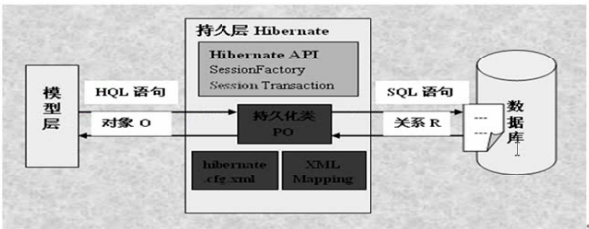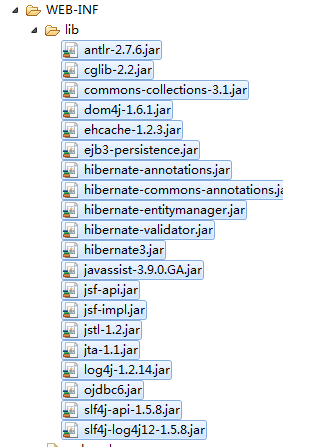Hibernate框架简介(二)基本使用增、删、改、查
一、Hibernate框架简介
Hibernate是一个优秀的Java持久化层解决方案,是当今主流的对象-关系映射(ORM,ObjectRelationalMapping)工具
1.1、理解持久化
- 瞬时状态:在程序运行的时候,有些程序数据是保存在内存中,当程序退出后,这些数据就不复存在了,所以称这些数据的状态为瞬时状态
- 持久状态:在使用一此软件的时候,有些数据,在程序退出后,还以文件等形式保存在硬盘或者数据库中,称这些数据的状态是持久状态
- 持久化:持久化就是将程序中的数据在瞬时状态和持久状态之间转换的机制。(如:JDBC)
1.2、对象-关系映射(ORM)
Java是一种面象对象的设计语言。在程序运行时的数据是以对象形式存在内存中,而保存数据时,又要以对象的形式存在关系型数据库中。
ORM简单讲:就是能在对象和关系型数据库两者之间进行数据转换的机制。Hibernate就是这样一个中间的解决方案。关系如下图

1.3、ORM框架综述
ORM:对象关系映射(Object Relation Mapping)
Hibernate框架:能够实现ORM框架
Hibernate是一个优秀的Java持久化层解决方案,是当今主流的对象-关系映射(ORM,ObjectRelationalMap
Hibernate框架对JDBC时行和封装,简化了数据访问层。可应用在任何使用JDBC的场合如:Servlet、JSP的WEB应用,JAVA客户端等。

二、Hibernate下载
官网:http://sourceforge.net/projects/hibernate/files/hibernate3/
这里下载的是3.3.2GA,
解压后,将根目录下的hibernate3.jar和将lib目录下全部的jar导入项目中
同时将数据库驱动也导入这里使用Oracle 11g
 其中加入了一些其它的jar包如:JSTL包
其中加入了一些其它的jar包如:JSTL包
当然也可以用MyEclipse完全集成,不用下载
三、Hibernate配置
3.1、创建hibernate.cfg.xml文件.
这是配置文件默认名.一般放在src目录下:作用指定数据库连接的信息及映射文件路径
获取配置文件进行修改。当然如果记得了就全写也可以。在下载的Hibernate解压目录下就有配置文件模板
hibernate-distribution-3.3.2.GA-dist\hibernate-distribution-3.3.2.GA\project\tutorials\web\src\main\resources此目录下就有,将其复制到src目录下进行修改
<?xml version='1.0' encoding='utf-8'?>
<!DOCTYPE hibernate-configuration PUBLIC
"-//Hibernate/Hibernate Configuration DTD 3.0//EN"
"http://hibernate.sourceforge.net/hibernate-configuration-3.0.dtd"> <hibernate-configuration> <session-factory> <!-- Database connection settings -->
<!-- 数据库驱动 不同的数据库不一样-->
<property name="connection.driver_class">oracle.jdbc.driver.OracleDriver</property>
<!-- 数据库访问url 不同的数据库不一样-->
<property name="connection.url">jdbc:oracle:thin:@localhost:1521:orcl</property>
<!-- 数据库连接用户名 -->
<property name="connection.username">sa</property>
<!--数据库连接用户名的密码 -->
<property name="connection.password"></property> <!-- JDBC connection pool (use the built-in) -->
<!--数据库连接池默认连接数量 -->
<property name="connection.pool_size">2</property> <!-- SQL dialect -->
<!--方言,不同的数据不同的版都有所不同 -->
<property name="dialect">org.hibernate.dialect.HSQLDialect</property> <!-- Enable Hibernate's current session context -->
<!-- Session设置 -->
<property name="current_session_context_class">org.hibernate.context.ManagedSessionContext</property> <!-- Disable the second-level cache -->
<!--二级缓存 -->
<property name="cache.provider_class">org.hibernate.cache.NoCacheProvider</property> <!-- Echo all executed SQL to stdout -->
<!-- 在执行数据操作时,是不是在控制台显示SQL语句,true为显示 -->
<property name="show_sql">true</property> <!-- Drop and re-create the database schema on startup -->
<!--根据数据库表得到类,根据类到表 -->
<property name="hbm2ddl.auto">create</property>
<!--对类的配置文件映射 -->
<mapping resource="org/hibernate/tutorial/domain/Event.hbm.xml"/>
<mapping resource="org/hibernate/tutorial/domain/Person.hbm.xml"/> </session-factory> </hibernate-configuration>
这里暂时只做数据库的连接配置Oracle的
<?xml version='1.0' encoding='utf-8'?>
<!DOCTYPE hibernate-configuration PUBLIC
"-//Hibernate/Hibernate Configuration DTD 3.0//EN"
"http://hibernate.sourceforge.net/hibernate-configuration-3.0.dtd"> <hibernate-configuration> <session-factory> <!-- Database connection settings -->
<!-- 数据库驱动 不同的数据库不一样-->
<property name="connection.driver_class">oracle.jdbc.driver.OracleDriver</property>
<!-- 数据库访问url 不同的数据库不一样-->
<property name="connection.url">jdbc:oracle:thin:@localhost:1521:orcl</property>
<!-- 数据库连接用户名 -->
<property name="connection.username">accp</property>
<!--数据库连接用户名的密码 -->
<property name="connection.password">accp</property> </session-factory> </hibernate-configuration>
3.2、创建持久化类和映射文件
也就是创建实体类的配置文件如:Login.hbm.xml(Login为类名),并在hibernate.cfg.xml文件下方</session-factory>前面中添加映射文件路径
1、在数据库中创建一张表
create table login
(
username varchar2(20) primary key,
password varchar2(20)
);
2、创建Login实体类
package com.pb.entity;
/*
* 登录实体类
*/
public class Login {
private String username;
private String password; public String getUsername() {
return username;
}
public void setUsername(String username) {
this.username = username;
}
public String getPassword() {
return password;
}
public void setPassword(String password) {
this.password = password;
} }
3、在实体类的同一个包下创建实体类的配置文件
<?xml version='1.0' encoding='utf-8'?>
<!-- 这里与hibernate.cfg.xml配置文件不一样注意 -->
<!DOCTYPE hibernate-mapping PUBLIC
"-//Hibernate/Hibernate Configuration DTD 3.0//EN"
"http://hibernate.sourceforge.net/hibernate-mapping-3.0.dtd"> <!-- 这里与hibernate.cfg.xml配置文件不一样注意 --> <hibernate-mapping>
<!--类名和数据库中的表名相对应 哪个用户 -->
<class name="com.pb.entity.Login" table="LOGIN" schema="accp">
<!-- id代表主键 column列表 type代表数据类型-->
<!-- 类中的属性 -->
<id name="username" type="java.lang.String">
<!-- 表中哪一个字段或者是列名 -->
<column name="USERNAME" length="20" />
<!--生成的方式 assigned代表由外部外部程序负责生成,在 save() 之前必须指定一个-->
<!-- native由hibernate根据使用的数据库自行判断采用identity、hilo、sequence其中一种作为主键生成方式,灵活性很强。如果能支持identity则使用identity,如果支持sequence则使用sequence。-->
<generator class="assigned" />
</id>
<!-- 密码段设置 -->
<!--类中的名字和数据类型 -->
<property name="password" type="java.lang.String">
<!-- 表中的字段名,长度可心不要,是不为空true为不能为空,false是可以为空 -->
<column name="PASSWORD" length="20" not-null="true"/>
</property>
<!--如果还有其它的属性,设置方式与password一样设置 -->
</class>
</hibernate-mapping>
在src下的配置文件中添加映射
<?xml version='1.0' encoding='utf-8'?>
<!DOCTYPE hibernate-configuration PUBLIC
"-//Hibernate/Hibernate Configuration DTD 3.0//EN"
"http://hibernate.sourceforge.net/hibernate-configuration-3.0.dtd"> <hibernate-configuration> <session-factory> <!-- Database connection settings -->
<!-- 数据库驱动 不同的数据库不一样-->
<property name="connection.driver_class">oracle.jdbc.driver.OracleDriver</property>
<!-- 数据库访问url 不同的数据库不一样-->
<property name="connection.url">jdbc:oracle:thin:@localhost:1521:orcl</property>
<!-- 数据库连接用户名 -->
<property name="connection.username">accp</property>
<!--数据库连接用户名的密码 -->
<property name="connection.password">accp</property>
<!--为实体类配置文件添加映射 -->
<mapping resource="com/pb/entity/Login.hbm.xml"/>
</session-factory> </hibernate-configuration>
3.3、创建Hibernate连接工具类
Hibernater主要接口和类:
Configuration
SessionFactory:DriverManager
Session:Connection
Transaction
Query:Statement和PreparedStatement
在下载的包中有提供好的一个比较简单的工具类
package com.pb.until; import org.hibernate.SessionFactory;
import org.hibernate.cfg.Configuration; public class HibernateUtil { private static final SessionFactory sessionFactory; static {
try {
// Create the SessionFactory from hibernate.cfg.xml
sessionFactory = new Configuration().configure().buildSessionFactory();
} catch (Throwable ex) {
// Make sure you log the exception, as it might be swallowed
System.err.println("Initial SessionFactory creation failed." + ex);
throw new ExceptionInInitializerError(ex);
}
} public static SessionFactory getSessionFactory() {
return sessionFactory;
} }
这个比较,也可以增加一功能
相比较MyEclipse提供的一个比较完美
package com.pb.until; import org.hibernate.HibernateException;
import org.hibernate.Session;
import org.hibernate.cfg.Configuration; /**
* Configures and provides access to Hibernate sessions, tied to the
* current thread of execution. Follows the Thread Local Session
* pattern, see {@link http://hibernate.org/42.html }.
*/
public class HibernateSessionFactory { /**
* Location of hibernate.cfg.xml file.
* Location should be on the classpath as Hibernate uses
* #resourceAsStream style lookup for its configuration file.
* The default classpath location of the hibernate config file is
* in the default package. Use #setConfigFile() to update
* the location of the configuration file for the current session.
*/
private static String CONFIG_FILE_LOCATION = "/hibernate.cfg.xml";
private static final ThreadLocal<Session> threadLocal = new ThreadLocal<Session>();
private static Configuration configuration = new Configuration();
private static org.hibernate.SessionFactory sessionFactory;
private static String configFile = CONFIG_FILE_LOCATION; static {
try {
configuration.configure(configFile);
sessionFactory = configuration.buildSessionFactory();
} catch (Exception e) {
System.err
.println("%%%% Error Creating SessionFactory %%%%");
e.printStackTrace();
}
}
private HibernateSessionFactory() {
} /**
* Returns the ThreadLocal Session instance. Lazy initialize
* the <code>SessionFactory</code> if needed.
*
* @return Session
* @throws HibernateException
*/
public static Session getSession() throws HibernateException {
Session session = (Session) threadLocal.get(); if (session == null || !session.isOpen()) {
if (sessionFactory == null) {
rebuildSessionFactory();
}
session = (sessionFactory != null) ? sessionFactory.openSession()
: null;
threadLocal.set(session);
} return session;
} /**
* Rebuild hibernate session factory
*
*/
public static void rebuildSessionFactory() {
try {
configuration.configure(configFile);
sessionFactory = configuration.buildSessionFactory();
} catch (Exception e) {
System.err
.println("%%%% Error Creating SessionFactory %%%%");
e.printStackTrace();
}
} /**
* Close the single hibernate session instance.
*
* @throws HibernateException
*/
public static void closeSession() throws HibernateException {
Session session = (Session) threadLocal.get();
threadLocal.set(null); if (session != null) {
session.close();
}
} /**
* return session factory
*
*/
public static org.hibernate.SessionFactory getSessionFactory() {
return sessionFactory;
} /**
* return session factory
*
* session factory will be rebuilded in the next call
*/
public static void setConfigFile(String configFile) {
HibernateSessionFactory.configFile = configFile;
sessionFactory = null;
} /**
* return hibernate configuration
*
*/
public static Configuration getConfiguration() {
return configuration;
} }
根据需要选择
四、Hibernate的持久化操作的步骤
4.1、读取并散板配置文件
Configuration config=new Configuration().configure();
4.2、读取并解析映射信息,创建SessionFactory
SessionFactory factory=config.buildSessionFactory();
4.3、打开session
Session session=factory.openSessin();
4.4、开始一个事务(增、删、改操作必须,查询操作可选)
Transaction tran=session.beginTransaction();
4.5、操作化操作
session.save(对象);
session.update(对象);
session.delete(对象);
session.get(主键之类的);
4.6、提交事务
tran.commit();
4.7、关闭session
session.close();
五、Hibernate使用
实现增、删、改、查的类
package com.pb.LoginDao; import java.util.List; import org.hibernate.HibernateException;
import org.hibernate.Query;
import org.hibernate.Session;
import org.hibernate.Transaction; import com.pb.entity.Login;
import com.pb.until.HibernateSessionFactory;
import com.pb.until.HibernateUtil; public class LoginDao { /*
* 增加
*/
public void save(Login login) {
// 得到Session
Session session = HibernateUtil.getSessionFactory().openSession();
Transaction tran = null;
// 也可以
// Session session=new
// Configuration().configure().buildSessionFactory().openSession();
try {
// 打开事务
tran = session.beginTransaction();
// 执行数据添加
session.save(login);
// 提交事务
tran.commit();
System.out.println("用户信息添加成功");
} catch (HibernateException e) {
// 事务回滚
tran.rollback();
e.printStackTrace();
System.out.println("用户信息添加失败");
} finally {
// 关闭session
session.close();
} } /*
* 修改根据用户名
*/
public void update(Login login) {
// 得到Session
Session session = HibernateUtil.getSessionFactory().openSession();
Transaction tran = null;
// 也可以
// Session session=new
// Configuration().configure().buildSessionFactory().openSession();
try {
// 打开事务
tran = session.beginTransaction();
// 执行数据添加
session.update(login);
// 提交事务
tran.commit();
System.out.println("用户信息修改成功");
} catch (HibernateException e) {
// 事务回滚
tran.rollback();
e.printStackTrace();
System.out.println("用户信息修改失败");
} finally {
// 关闭session
session.close();
}
} /*
* 修改根据用户名修改密码
*/
public void delte(Login login) {
// 得到Session
Session session = HibernateUtil.getSessionFactory().openSession();
Transaction tran = null;
// 也可以
// Session session=new
// Configuration().configure().buildSessionFactory().openSession();
try {
// 打开事务
tran = session.beginTransaction();
// 执行数据添加
session.delete(login);
// 提交事务
tran.commit();
System.out.println("用户信息删除成功");
} catch (HibernateException e) {
// 事务回滚
tran.rollback();
e.printStackTrace();
System.out.println("用户信息删除失败");
} finally {
// 关闭session
session.close();
}
} /*
* 查询一查询全部用户
*/
public List<Login> QueryALL() {
// 使用myeclipse提供的工具类来得到session
Session session = HibernateSessionFactory.getSession();
// 建立查询
Query query = session.createQuery("from Login");
// 查询重到List集合
List<Login> list = query.list();
// 关闭session
session.close();
// 返回结果集合
return list;
} /*
* 查询二 查询指定的用户名的
*/
public Login QueryByName(String username) {
// 使用myeclipse提供的工具类来得到session
Session session = HibernateSessionFactory.getSession();
// 建立查询
Query query = session.createQuery("from Login l where l.username=?");
// 占位
query.setString(0, username); // 查询返回唯一
Login login = (Login) query.uniqueResult();
// 关闭session
session.close();
// 返回结果集合
return login;
} /*
* 查询三,模糊查询
*/
public List<Login> QueryLikeName(String username) {
// 使用myeclipse提供的工具类来得到session
Session session = HibernateSessionFactory.getSession();
// 建立查询
Query query = session
.createQuery("from Login l where l.username like ?");
// 占位
query.setString(0, "%" + username + "%");
// 查询重到List集合
List<Login> list = query.list();
// 关闭session
session.close();
// 返回结果集合
return list;
} }
测试类:
package com.pb.test; import java.util.List; import com.pb.LoginDao.LoginDao;
import com.pb.entity.Login; public class Test { public static void main(String[] args) {
//声明LoginDao对象
LoginDao loginDao=new LoginDao();
//声明对象并赋初始值
Login login=new Login();
login.setUsername("Jack");
login.setPassword("blue");
//执行添加
loginDao.save(login);
//执行修改
login.setUsername("Jack");
login.setPassword("while");
loginDao.update(login);
//执行删除
loginDao.delte(login); System.out.println("=========查询全部========");
//查询全部
List<Login> list=loginDao.QueryALL();
for (Login log : list) {
System.out.println("用户名:"+log.getUsername()+" 密码:"+log.getPassword());
} System.out.println("=========精确查询========");
//查询一个用户
Login lg=loginDao.QueryByName("ffff");
if(lg!=null){
System.out.println("用户名:"+lg.getUsername()+" 密码:"+lg.getPassword());
}else{
System.out.println("没有此用户");
}
System.out.println("=========模糊查询========");
//模糊查询
List<Login> likelist=loginDao.QueryLikeName("t");
for (Login lo : likelist) {
System.out.println("用户名:"+ lo.getUsername()+" 密码:"+ lo.getPassword());
}
} }
Hibernate框架简介(二)基本使用增、删、改、查的更多相关文章
- 好用的SQL TVP~~独家赠送[增-删-改-查]的例子
以前总是追求新东西,发现基础才是最重要的,今年主要的目标是精通SQL查询和SQL性能优化. 本系列主要是针对T-SQL的总结. [T-SQL基础]01.单表查询-几道sql查询题 [T-SQL基础] ...
- iOS FMDB的使用(增,删,改,查,sqlite存取图片)
iOS FMDB的使用(增,删,改,查,sqlite存取图片) 在上一篇博客我对sqlite的基本使用进行了详细介绍... 但是在实际开发中原生使用的频率是很少的... 这篇博客我将会较全面的介绍FM ...
- iOS sqlite3 的基本使用(增 删 改 查)
iOS sqlite3 的基本使用(增 删 改 查) 这篇博客不会讲述太多sql语言,目的重在实现sqlite3的一些基本操作. 例:增 删 改 查 如果想了解更多的sql语言可以利用强大的互联网. ...
- django ajax增 删 改 查
具于django ajax实现增 删 改 查功能 代码示例: 代码: urls.py from django.conf.urls import url from django.contrib impo ...
- MVC EF 增 删 改 查
using System;using System.Collections.Generic;using System.Linq;using System.Web;//using System.Data ...
- ADO.NET 增 删 改 查
ADO.NET:(数据访问技术)就是将C#和MSSQL连接起来的一个纽带 可以通过ADO.NET将内存中的临时数据写入到数据库中 也可以将数据库中的数据提取到内存中供程序调用 ADO.NET所有数据访 ...
- python基础中的四大天王-增-删-改-查
列表-list-[] 输入内存储存容器 发生改变通常直接变化,让我们看看下面列子 增---默认在最后添加 #append()--括号中可以是数字,可以是字符串,可以是元祖,可以是集合,可以是字典 #l ...
- Go语言之进阶篇mysql增 删 改 查
一.mysql操作基本语法 1.创建名称nulige的数据库 CREATE DATABASE nulige DEFAULT CHARSET utf8 COLLATE utf8_general_ci; ...
- oracle 11g 建库 建表 增 删 改 查 约束
一.建库 1.(点击左上角带绿色+号的按钮) 2.(进入这个界面,passowrd为密码.填写完后点击下面一排的Test按钮进行测试,无异常就点击Connect) 二.建表 1-1. create t ...
随机推荐
- IOS7开发~Images.xcassets
from:http://blog.csdn.net/liufan321/article/details/9121241 新建项目,如下所示: 本文分享一下Images.xcassets的体验~_~ 1 ...
- js 闭包范式概述
在前几篇文章中我介绍过js的闭包,这一篇主要简单的介绍一下js中闭包的范式. 那么何谓闭包的范式呢? 首先回想一下闭包的概念,闭包是外部函数与函数内部之间通信的桥梁,通过对函数的返回,使得外部的函数能 ...
- Tasker : Task / Shortcut Widgets
Task / Shortcut Widgets The standard way of running a Tasker task is by attaching it to a profile wh ...
- BitmapFactory.Options.inSampleSize 的使用方法
BitmapFactory.decodeFile(imageFile); 用BitmapFactory解码一张图片时.有时会遇到该错误. 这往往是因为图片过大造成的. 要想正常使用,则须要分配更少的内 ...
- MVC二级联动使用$.getJSON方法
本篇使用jQuery的$.getJSON()实现二级联动. □ View Models 1: namespace MvcApplication1.Models 2: { 3: public cla ...
- EF三种加载方法
EF性能之关联加载 鱼和熊掌不能兼得 ——中国谚语 一.介绍 Entity Framework作为一个优秀的ORM框架,它使得操作数据库就像操作内存中的数据一样,但是这种抽象是有性能代价的,故鱼和 ...
- 【BestCoder】【Round#44】
模拟+Trie+桶排(归并?)+容斥 A 模(shou)拟(su)题= =感觉好像见过? 计算得分什么的…… //BestCoder #44 A #include<vector> #inc ...
- 在Java程序中使用Hibernate
Hibernate是一种ORM框架,ORM全称为Object-Relative Database-Mapping,在Java对象与关系数据库之间建立某种映射,以实现直接存取Java对象(一般为实体类) ...
- hdu 4107 Gangster(线段树,时间卡得很严)
这道题目的数据卡得好厉害. 题目明显是考察线段树延迟标记的,但是因为要考虑到p的值,这种延迟是有条件的:在该节点下所有的数据对于p都应该位于p的同一侧.要么都比p大,要么都比p小. 开始的时候我用一个 ...
- go语言之进阶篇面向对象编程
1.面向对象编程 对于面向对象编程的支持Go 语言设计得非常简洁而优雅.因为, Go语言并没有沿袭传统面向对象编程中的诸多概念,比如继承(不支持继承,尽管匿名字段的内存布局和行为类似继承,但它并不是继 ...
